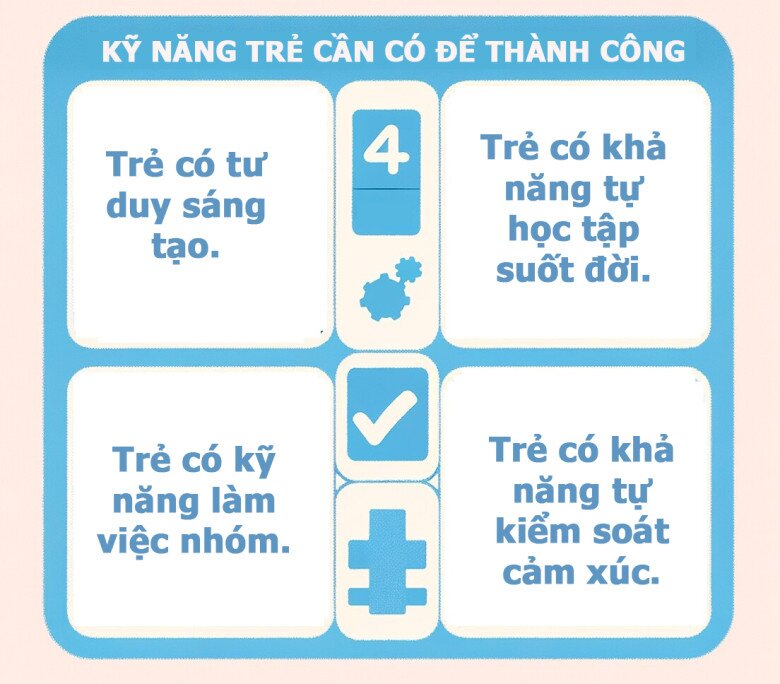In a constantly changing world, children need to be equipped with essential skills and strong personal qualities to survive and thrive.


Creative Thinkers
Society is changing rapidly, and whether or not children have creative thinking skills will become a core competency for securing a standing and developing in the future. This allows children to break habits, explore, and solve problems from a unique perspective, paving their own path.

To determine if your child is a creative thinker, parents should observe the following:
– Children are naturally curious and ask a lot of “why” and “what if” questions. For example, “If clouds became sweet, could we eat them like candy?”
– They have many small ideas and can offer multiple solutions when faced with a problem, demonstrating a rich imagination.
– Children enjoy hands-on exploration and often use Lego, clay, or recycled materials to create something new from their imagination.
– Children are not afraid to be different and are happy to express their unique ideas without fearing being labeled as “weird.”
If your child displays these traits, parents should nurture and stimulate this precious spark of creativity.
Provide open-ended materials: Offer a variety of toys, such as Lego blocks, colored clay, paintbrushes, and sand, to encourage children to create freely. Emphasize “daring to think and act” instead of focusing on whether their creations look realistic.
Ask more questions to inspire: When children ask questions, parents should refrain from providing immediate answers. Instead, ask, “What do you think?” Protecting their courage to ask questions is more important than giving them the answers.
Establish dedicated creative time: Set a fixed time each week for the family to engage in creative activities without a specific purpose, such as crafting with recycled materials, leaf collage, or story adaptation.
Important reminder: Parents should avoid hastily dismissing their children’s “weird ideas” or correcting their “mistakes,” as these are often the starting points for new discoveries. Say “that’s interesting, let’s give it a try!” more often instead of saying “no” or “that’s wrong.”

Lifelong Learners
In the future, with the rapid explosion of knowledge and technological advancements, the “hard skills” learned today may become outdated or require updates tomorrow.
Therefore, lifelong learning will give children the internal drive to actively seek knowledge, embrace change, and continuously upgrade themselves in the long race of life.
Parents should observe if their children display the following traits:
– Inquisitive explorers: Children often ask questions about things they don’t understand (“How does this work?”) and are willing to actively seek answers (by researching or experimenting) and enjoy the process of learning.
– Resilient warriors: They don’t give up easily when faced with difficulties (such as making mistakes in a puzzle or falling off a bike). They view challenges as opportunities to learn and grow.
– Attentive to learning methods: Children try different memory techniques, summarize rules, and make connections between new and old knowledge (“Hey, this is similar to what we learned last time!”).
– Open-minded: They are interested in new activities, books, and skills (such as learning new dishes or studying dinosaurs) and are not afraid of novelty and complexity.

Parents are the key to unlocking their children’s learning potential
Protect their curiosity and become their learning partner: When children ask questions, don’t give direct answers. Instead, say, “That’s a great question! Let’s find out together.” Help them understand that learning is a lifelong joy.
Focus on the process, not just the outcome: Ask fewer questions about grades and winning, and more about the process, such as “What new methods did you try?” and “What did you learn from this?” Encourage them to think about strategies and reflect on overcoming difficulties, allowing them to experience the joy of progress.
Build a shared learning approach and environment
Guided learning method: Encourage deep questioning, safe information gathering, breaking tasks into manageable steps, and regular reviews and summaries (“What did we do well? What could we have done differently?”).
Create a learning atmosphere: Keep books within reach and read and discuss them with your children often. Allow for safe and slightly messy exploration, integrating learning into everyday life (research projects, gardening, discussing current events) to show that learning opportunities are everywhere.
Important reminder: Protecting their intrinsic motivation and curiosity is far more important than pushing them to acquire knowledge. Instead of rushing them to “learn faster,” ask about their interests and what they find fascinating. Let them experience the satisfaction of completing a learning task.

Effective Team Players
As future challenges become increasingly complex, teamwork skills will be a crucial passport for children to integrate into groups and achieve success. It enables them to understand how to work with others, combining the strengths of “me” into a powerful “us” to achieve shared goals.
Children who exhibit strong teamwork skills often display the following qualities. Parents can observe if their children:
Collaborate with a shared goal: During group activities, they focus on their individual tasks while also being concerned about the group’s objectives (“How can we build this better?” “What do you need me to do?”). They actively cooperate by offering Lego blocks to others, for example.
Willing to share: They readily share toys, ideas, achievements, and proactively help when their friends encounter difficulties.
Good listeners and communicators: They express their opinions clearly, listen carefully to understand different perspectives, propose compromises, and promote harmony during disputes. Even as group leaders, they focus on coordinating tasks, encouraging members, resolving conflicts, ensuring everyone is valued, and contributing to the common goal.

If your child displays these signs, ensure you nurture and develop their collaborative skills. Parents should:
Create collaboration opportunities: Organize activities that require cooperative efforts, such as solving puzzles or sharing household chores, so children can experience the value of working together.
Guide children in conflict resolution: When conflicts arise during collaboration, avoid direct judgment. Intervene timely to guide communication (“How do you feel about this?” “How can we resolve this fairly and happily?”), teaching them to negotiate and compromise.
Model and emphasize listening: Demonstrate careful listening in daily communication. Encourage post-activity sharing, asking, “Whose idea was brilliant?” and “What are the benefits of listening?” to help children understand that listening is the foundation of respect and collaboration.
Praise cooperative behaviors: After completing a task, focus on praising specific cooperative behaviors (“It was thoughtful of you to hand over the tools,” “It was great how we solved the problem together,” “It was wonderful how you listened quietly during the discussion”) to reinforce positive actions.
Important reminder: Parents should avoid comparing children to other group members or forcing collaboration, as this may diminish their willingness to cooperate. Instead, make collaboration a fun experience rather than a burden.

Emotionally Intelligent
The future is full of pressure and uncertainty. Emotional intelligence is a core capability that enables children to think clearly, make rational decisions, and maintain healthy relationships. It serves as an “internal stabilizer” to cope with challenges and protect their mental health.
What are the common behaviors of emotionally intelligent children? Parents should observe if their children:
Can “hit the brakes”: When strong emotions (anger, frustration) arise, they restrain themselves from hitting others, throwing things, or saying hurtful words. For example, if their toy is taken away, they say, “I’m angry!” instead of pushing others.
Utilize pauses effectively: When emotions peak, they proactively leave the scene or take deep breaths to calm down and avoid explosions.
Express themselves verbally: They gradually learn to express their emotions and needs (“I’m scared,” “I don’t like this,” “I need some time”) instead of just crying.
Are resilient: They feel sad when faced with failure (losing a game, breaking a toy) but can quickly calm down and try to accept or solve the problem.

If your child excels in these areas, cherish and continue to nurture this precious inner strength by:
Receiving and interpreting their emotions: When children express strong emotions, don’t judge or stop them. Calmly say, “I can see you’re feeling sad. Is it because of…?” Help them name and accurately identify their emotions.
– Teach calming tools: For example, practice deep breathing, create a “calm corner,” and tell them they can go there to relax when their emotions fluctuate.
– Practice in daily routines: Parents should also seize opportunities during everyday situations like waiting in line or delayed gratification to gently guide them (“You need to wait,” “I know you want to eat, but are you a little disappointed? Let’s try something else first”) to accumulate experience in coping with minor failures.
Important reminder: Parents should avoid scolding, punishing, or compromising without principles when children have emotional outbursts. Instead, view every emotional fluctuation as a learning opportunity to develop better emotional regulation.
The future is approaching fast. Children with kind hearts, positive thinking, collaboration, and self-regulation will have the resilience and adaptability to build a stronger future, regardless of their chosen field or the changes they face.
Therefore, parents should carefully nurture these core competencies, giving their children a competitive edge for the long term. Nurture these seeds of potential, and a bright future will bloom.
“5 Fun and Easy At-Home Games to Nurture Your Child’s Emotional Intelligence”
Emotional intelligence is a vital skill for children to understand themselves, empathize with others, and navigate social situations effectively. Parents can easily foster this skill through simple and engaging activities at home. The following are five fun and effective ways to start building your child’s emotional intelligence today.







































